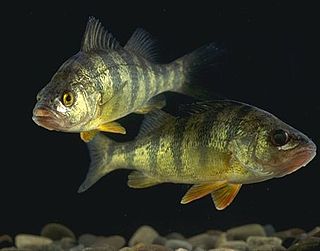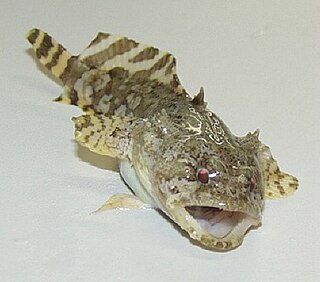
The Percidae are a family of ray-finned fish, part of the order Perciformes, which are found in fresh and brackish waters of the Northern Hemisphere. The majority are Nearctic, but there are also Palearctic species. The family contains more than 200 species in 11 genera. The perches and their relatives are in this family; well-known species include the walleye, sauger, ruffe, and three species of perch. However, small fish known as darters are also a part of this family.

The Squaliformes are an order of sharks that includes about 126 species in seven families.

The members of the family Percichthyidae are known as the temperate perches. They belong to the order Perciformes, the perch-like fishes.

Parrotfish are a group of fish species traditionally regarded as a family (Scaridae), but now often treated as a subfamily (Scarinae) or tribe (Scarini) of the wrasses (Labridae). With roughly 95 species, this group's largest species richness is in the Indo-Pacific. They are found in coral reefs, rocky coasts, and seagrass beds, and can play a significant role in bioerosion.

Batrachoididae is the only family in the ray-finned fish order Batrachoidiformes. Members of this family are usually called toadfish or frogfish: both the English common name and scientific name refer to their toad-like appearance.
Squalidae, more commonly known as dogfish, dog sharks, or spiny dogfish, are one of several families of sharks categorized under Squaliformes, making it the second largest order of sharks, numbering 119 species across 7 families. Having earned their name after a group of fishermen reportedly observed the species chasing down smaller fish in dog-like packs, dogfish have slender, streamlined bodies, usually more compact in comparison to other species, and a pointed snout. Dogfish likewise have two dorsal fins, each with smooth spines, but no anal fin, and their skin is generally rough to the touch. As the species reaches adulthood, males usually measure a maximum of 100 cm, while females typically measure 125 cm long. The species therefore exhibits female-dominant sexual dimorphism.

Notothenioidei is one of 19 suborders of the order Perciformes. The group is found mainly in Antarctic and Subantarctic waters, with some species ranging north to southern Australia and southern South America. Notothenioids constitute approximately 90% of the fish biomass in the continental shelf waters surrounding Antarctica.
George Sprague Myers was an American ichthyologist who spent most of his career at Stanford University. He served as the editor of Stanford Ichthyological Bulletin as well as president of the American Society of Ichthyologists and Herpetologists. Myers was also head of the Division of Fishes at the United States National Museum, and held a position as an ichthyologist for the United States Fish and Wildlife Service. He was also an advisor in fisheries and ichthyology to the Brazilian Government.

Tetraroginae is a subfamily of marine ray-finned fishes, commonly known as waspfishes or sailback scorpionfishes, belonging to the family Scorpaenidae, the scorpionfishes and their relatives. These fishes are native to the Indian Ocean and the West Pacific. As their name suggests, waspfishes are often venomous; having poison glands on their spines. They are bottom-dwelling fish, living at depths to 300 metres (980 ft). These creatures usually live in hiding places on the sea bottom.

Assessor macneilli, the blue devilfish or blue scissortail, is a fish from the southwest Pacific Ocean. It occasionally makes its way into the aquarium trade. It grows to 6 centimetres (2.4 in) in length. It is purple-blue with long fins.

Pholidichthys leucotaenia, commonly known as the convict blenny/goby or the engineer blenny/goby, is a marine fish from the west-central Pacific Ocean. Despite its common names, it is neither a blenny nor a goby, but is in fact one of two species in the family Pholidichthyidae.

Synanceia is a genus of ray-finned fish belonging to the subfamily Synanceiinae, the stonefish, which is classified within the family Scorpaenidae, the scorpionfish and relatives. Stonefish are the most venomous fish known; stings can be fatal to humans. They are found in the coastal regions of the Indo-Pacific. They are sometimes confused with the freshwater lionfish.

The anglerfish are fish of the teleost order Lophiiformes. They are bony fish named for their characteristic mode of predation, in which a modified luminescent fin ray acts as a lure for other fish. The luminescence comes from symbiotic bacteria, which are thought to be acquired from seawater, that dwell in and around the sea.

An anchovy is a small, common forage fish of the family Engraulidae. Most species are found in marine waters, but several will enter brackish water, and some in South America are restricted to fresh water.

The Nemacheilidae, or stone loaches, are a family of cypriniform fishes that inhabit stream environments, mostly in Eurasia, with one genus, Afronemacheilus found in Africa. The family includes about 790 species.

Sebastiscus is a genus of marine ray-finned fish belonging to the subfamily Sebastinae part of the family Scorpaenidae. These fishes are native to the western Pacific Ocean. They are collectively called sea ruffes and resemble the rockfishes in the genus Sebastes, but are usually smaller and have a different pattern.

Opecoelidae is a family of trematodes. It is the largest digenean family with over 90 genera and nearly 900 species, almost solely found in marine and freshwater teleost fishes. It was considered by Bray et al. to belong in the superfamily Opecoeloidea Ozaki, 1925 or the Brachycladioidea Odhner, 1905.

Cichliformes is an order of fishes. Its members were previously classified under the order Perciformes, but now many authorities consider it to be an independent order within the subseries Ovalentaria.

Goby is a common name for many species of small to medium sized ray-finned fish, normally with large heads and tapered bodies, which are found in marine, brackish and freshwater environments.
Assessor randalli, Randall's assessor or Randall's devilfish, is a species of ray-finned fish belonging to the family Plesiopidae, the longfins or roundheads. It is found in the western Pacific Ocean, mainly in the seas around Japan and Taiwan. It is a similar species to Assessor macneilli but it is slightly brighter in colour and has more rounded rounder fins which have with yellow markings, there are also yellow markings on its body. They are associated with crevices and gullies in reefs, where they hover at the entrances to caves and holes. They are mouthbrooders, the male guards the eggs by keeping them in his mouth until they hatch. They are rare in the Aquarium trade but have been bred in captivity. The specific name honours the ichthyologist John Ernest Randall of the Bishop Museum in Honolulu, who collected the type specimen.
















